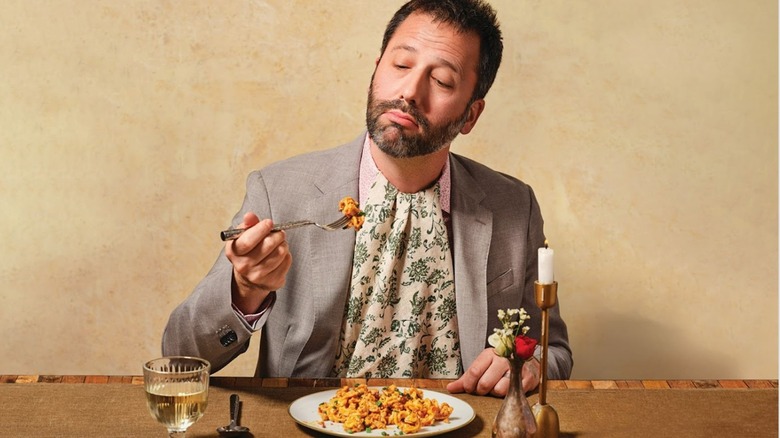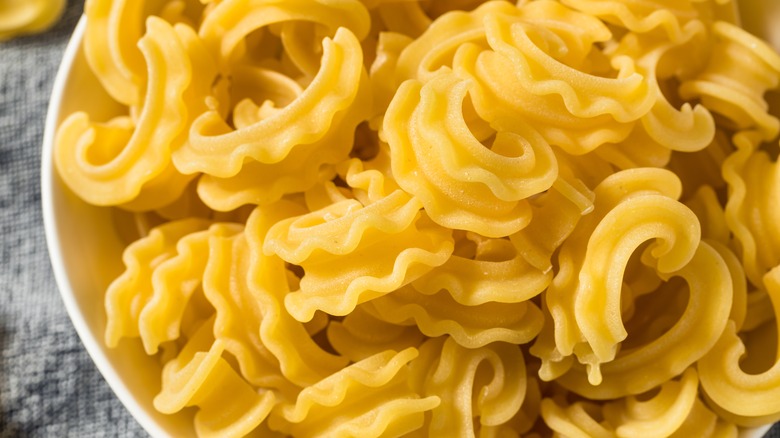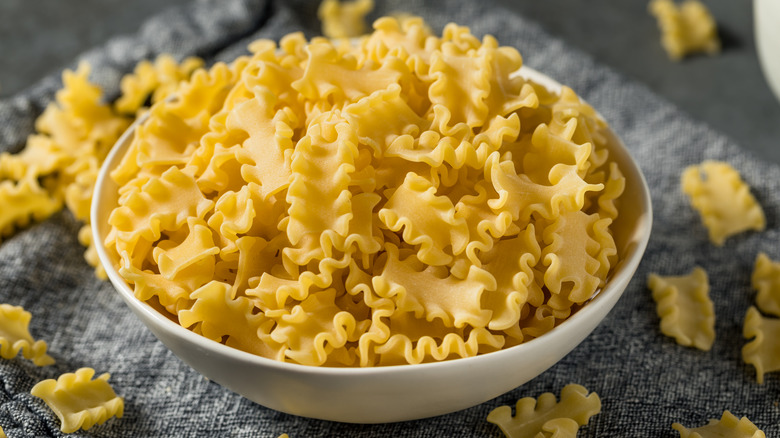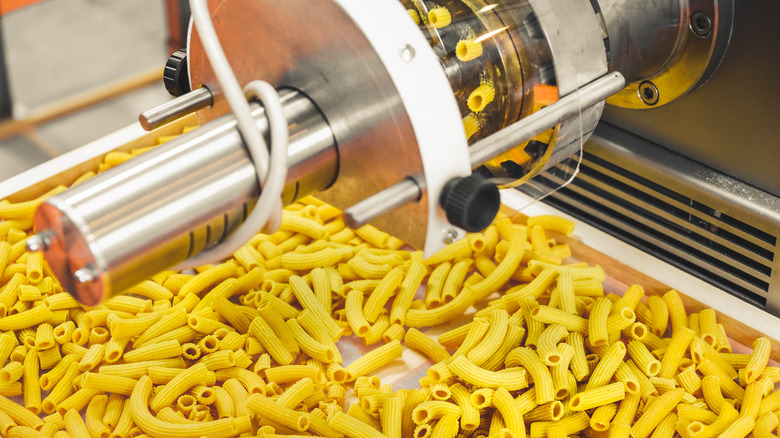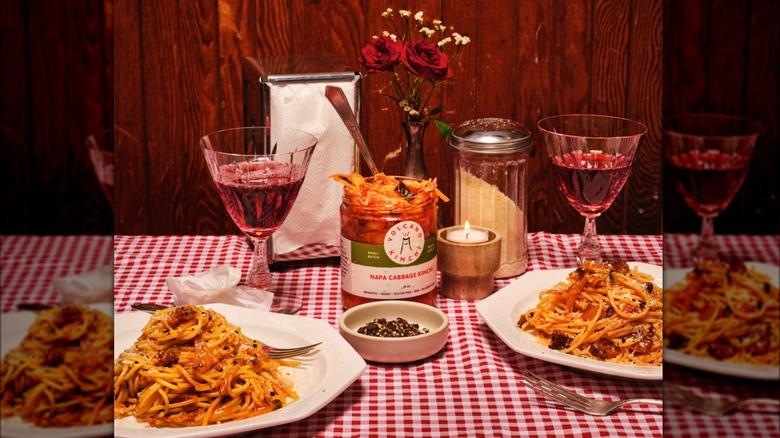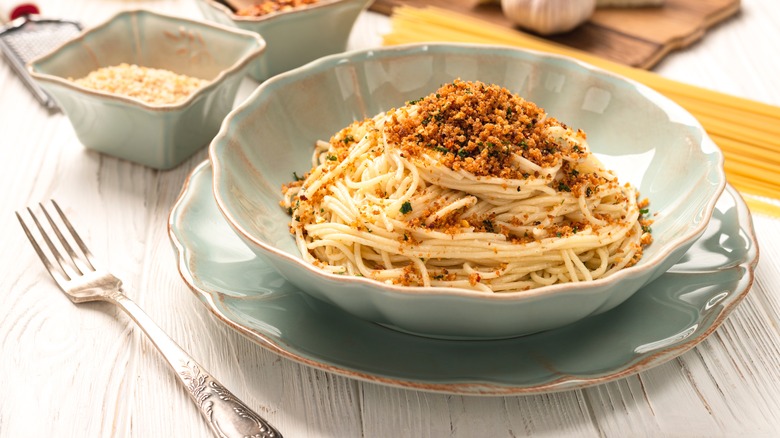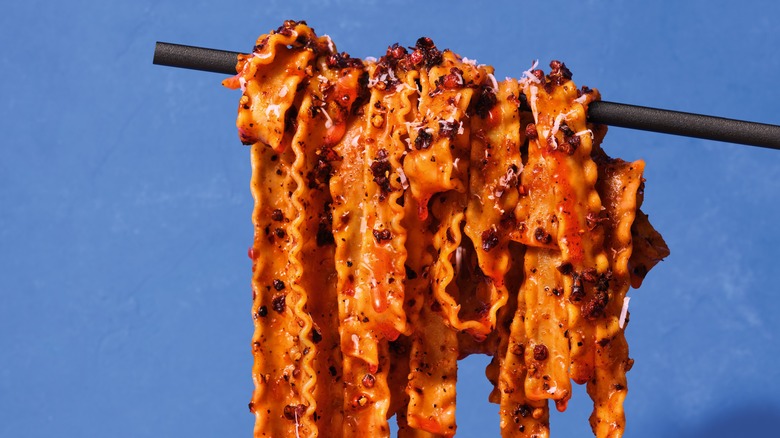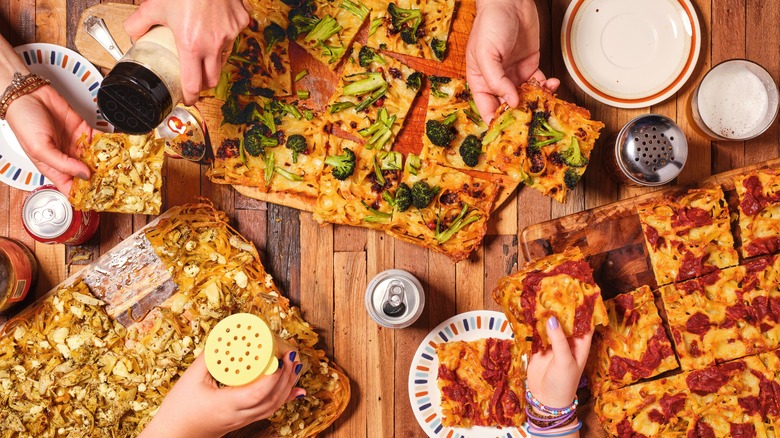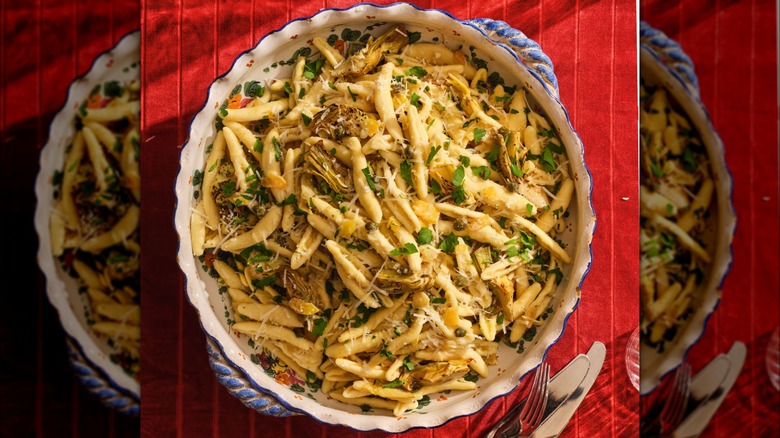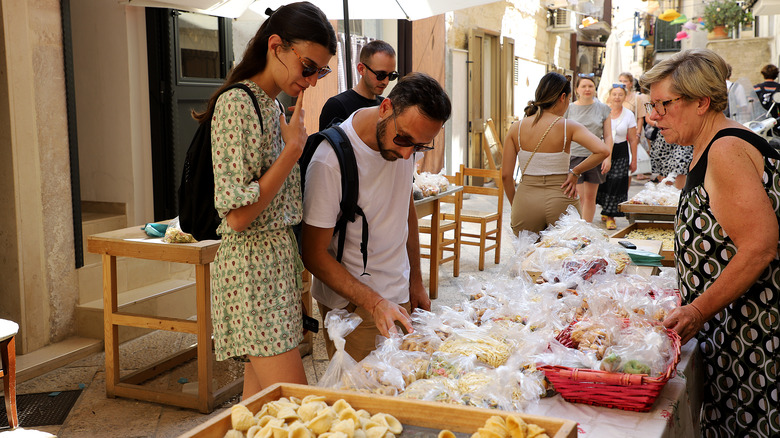Dan Pashman On The Constant Evolution Of Italian Food And What It Means For Your Bowl Of Pasta - Exclusive Interview
We may receive a commission on purchases made from links.
Pasta is a pantry staple in many households and an easy meal when time is limited. Just boil water, cook your desired shape, and serve it with tomato or meat sauce, right? "The Sporkful" podcast host Dan Pashman refuses to limit his palate to such a standard run-of-the-mill pairing. In an exclusive interview with Tasting Table, Pashman shares the inside scoop on the makings of his latest cookbook, "Anything's Pastable." The home cook knows a thing or two about pasta, having invented a new shape that Time designated as one of the Best Inventions of the Year in 2021.
The pasta in question, cascatelli, inspired Pashman to rethink traditional pasta and sauce pairings, leading him to write a cookbook to elaborate on the many ideas. He offers readers easy pasta cooking tips for success and identifies key ingredients that will take your pasta to the next level. If you're ready to explore beyond the jar of tomato sauce in your pantry, there are countless recipes in the book to titillate your taste buds.
The thought process leading up to the invention of cascatelli
You have lots of strong opinions about how different foods should be eaten or served. Was there a tipping point that led you to remaster pasta, aside from not liking the shapes that currently existed?
Part of it was just that I wanted to tell a big epic story on my podcast. I thought trying to invent a food would be full of ups and downs, and I didn't know where it would lead, and I didn't know whether it would work. But I figured if it's a big success or a total failure, it'll make for a good story.
Once I decided I wanted to try to invent a new food, I was thinking a lot about my frustrations with a lot of the traditional pasta shapes. But also some of the factors were that I wanted it to be something that was shelf stable, that was inexpensive, something that could easily be shared with people all over the country, all over North America, if not all over the world. I didn't want it to just be some sort of precious boutique-y thing that was in three markets in trendy neighborhoods. And so pasta is something that everybody knows, everybody mostly loves and has opinions about. It just felt like it fit with my personality and the kind of storytelling that I like to do.
Well it was very successful! What were the various iterations of cascatelli?
I started eating every obscure pasta shape I could get my hands on and just sort of get my teeth on, I should say, and just isolating variables. Do I like ruffles or ridges? Do I like long or short? Do I like tubes? Do I like curls? And just kind of isolating the different properties of shapes and trying to focus on what I like the best.
Mafalde was a big one for me because I always loved that shape, but eating that one in my research really made me realize how great ruffles are in a pasta shape. They're not that common, there aren't that many shapes that have ruffles. There's a lot more tubes and ridges, but ruffles hold sauce just as well as tubes and ridges, if not better, depending on the sauce. Plus they just create a playful texture in your mouth ... And they're just kind of fun to look at. I feel like any pasta with ruffles just feels festive. And so that was my first thing: My shape will have ruffles. Come hell or high water, there will be ruffles.
And then I used to kind of be more opposed to bucatini because everybody's always saying, bucatini is so great because sauce gets into the tube, but it really doesn't get into the tube, it's too narrow. I always felt like bucatini was like a broken promise because it didn't do the thing people said it was supposed to do. But then in my research, I gave it another shot. And so I ate some and I realized what makes it great is not that it holds sauce so well, but it's got a fantastic springiness.
The thought process leading up to the invention of cascatelli (continued)
I'm a big texture eater, so I have these three criteria that I use to judge all pasta shapes. There's formability — how easy is it to get it on your fork and keep it there? Sauceability, how well does sauce adhere to it? And tooth sinkability, which is how satisfying is it to sink your teeth into it. People always claimed that bucatini had good sauceability, but it didn't. Its secret weapon is that it has phenomenal tooth sinkability, much better than spaghetti. Because it's hollow in the center, it has a springiness to it. A bigger tube kind of goes flat when you bite into it. But bucatini, because it's such a narrow tube, springs back. I wanted some of that springiness because [of its] tooth sinkability.
My big idea with cascatelli was I wanted it to have ruffles because they hold a ton of sauce and they're a great texture and they're playful. I wanted it to be thick and chewy, and I wanted it to have the springiness of bucatini. And I thought that if it had all these things it would also be forkable, and that was the idea.
How machinery and patience affect pasta results
What did you learn about the difference between bronze and Teflon dies while you were doing your research?
The bronze dies are the more traditional way of making pasta. They impart a rough surface on the pasta, which makes it more tactile like sandpaper, so it holds sauce better. That being said, there are good Teflon pastas out there. I feel like now there are companies making bronze die pasta on the cheap just because they know that if they put the word bronze on the package, people will assume it's better. There are some Teflon pastas that I think are better than some bronze die pastas, but it is an indicator of quality.
It is, on average, more expensive to make pasta using a bronze die. You can't make it as fast because it creates a lot of pasta dust in the factory that can jam up the machines ... if you just are interested in making the most amount of pasta as quickly and cheaply as possible, then you'll use Teflon. It is an indicator of quality, but not the only one.
Drying is a huge factor ... it is probably the most complicated part. And really good pasta will be dried very slowly. If you ever have pasta that kind of cracks and shatters, that usually means it was dried too quickly. With cascatelli especially, we have to dry it slowly so that it holds together.
You may notice that cheap pasta, even if you cook it just the exact right amount of time, it will be more rubbery than chewy. That's a result of the drying; it's because it's been dried too quickly. If you dry it slowly, it'll be more chewy, really satisfying to sink your teeth into it. Biting into pasta, it should feel like biting into the perfect steak while laying your head on a cool pillow at night.
The evolution of pasta in Italy
So you visited Italy to see all sorts of different pasta creations there. What was the most surprising pasta preparation that you learned about?
The most surprising thing about it was that what I learned was that pasta was not a major part of Italian food culture until about 100 years ago. Many of the most iconic Italian pasta dishes were invented, or sort of emerged more recently than that. Carbonara was only invented in the 1940s or '50s. According to one historian I spoke to, Italians didn't really settle on exactly what the recipe was until 25 or 30 years ago. I know there's a lot of romanticism and nostalgia around Italian food, and it is beautiful, and the traditions are wonderful, and the food is phenomenal, but it's not as old or as static as we've been led to believe. There are new ideas coming out of Italy in pasta.
I did a whole thing about this dish called spaghetti all'assassina that's only made in Bari, and that was invented around 1960. And only in the past 10 years, as it's gotten more popular, there's a new variation with broccoli rabe instead of tomato-based sauce.
I think that, yes, I love the traditions and the beauty of it, and I'm not trying to destroy any of it, but I do think that human beings are always going to be coming up with new ideas for food. You can't stop creative evolution from happening, and we shouldn't pretend that it doesn't happen in Italy and with Italian food all around the world because it does. I started off thinking of my cookbook as sort of kicking down the door of pasta culture that's too stuck in its ways. But I ended up really thinking of it more as a contribution to the ongoing and never-ending evolution of pasta.
Layering textured garnishes immediately enhances pasta
Was there an ingredient that really stood out during the recipe testing for its multipurpose uses?
I knew going in that I really wanted texture to be a big part of the recipes ... I love foods that bring together a variety of different interesting textures. And certainly there are a lot of Italian pasta dishes that use texture in interesting ways ... But in North America, I think most people are eating one of a handful of pasta dishes, and they're kind of all mono-textural. Maybe the sauce is a little thicker or a little thinner, but there's not a whole lot of crisp and crunch in our pasta in North America.
I have a whole section on pangrattato, seasoned toasted breadcrumbs, which are a common thing to sprinkle over pasta dishes in parts of Italy. Typically there they're doing it with toasted breadcrumbs, maybe with rosemary and garlic, a few herbs and spices. I wanted to kind of expand that. I'm doing a corn nut pangrattato with lime zest. We're doing a furikake pangrattato, so pulling from other cuisines. These are things that you can make in five or 10 minutes. You can make a big batch and freeze them for months. They're delicious on almost everything, even beyond pasta dishes.
Yeah, absolutely. Adding a textural crunch with some flavors from a different cuisine is a good way to bridge that gap when experimenting. You use panko crumbs in most of your pangrattato recipes. Is that for simplicity?
I mean I wasn't going to ask people to make their own breadcrumbs. There's no fresh pasta made from scratch in this cookbook, there's no three-hour marinara sauce, we're not making bread crumbs from stale bread. I mean, people can if they want, but I don't have the time to do that. I feel like panko crumbs are super easy. They're easy to find and the crumbs are a little bit bigger than other types of breadcrumbs, so I just feel like you're going to notice them a little more.
Do you have a favorite seasoning for it or a pasta dish and pangrattato pairing you especially like?
There's a seared mushroom one with a furikake pangrattato. The lime corn nut pangrattato is so good, you can put it on that. There's a shrimp ají amarillo dish you can put it on, but I mean, you can put it on string beans, you can put it on broccoli, you can put it on rice ... you can put it on anything.
The details and the bigger picture
Is there a pasta cooking method that you think should be challenged, maybe part of the boiling process or not tossing it directly with the sauce?
I mean, there are people out there who are questioning the idea of reserved pasta water. Some people say it doesn't actually really contain much starch so it doesn't really thicken. I haven't done the test myself. I think that if you accidentally dump your pasta water and forget, you can use hot water with a bit of salt. That said, pasta water has a great flavor. I think the big thing is most people don't put enough salt in their pasta water. I recommend for a pound of pasta, four quarts of water, two tablespoons of kosher salt.
I really tried very hard to make these recipes to build in some margin for error in the recipes and to give you good cues so you know what to look for. Every recipe in this book was cooked by at least four different people in four different kitchens. And I'm a home cook, I'm not a professional chef or a professional recipe developer ... That said, the one thing that I get kind of detailed about is cooking your pasta for the right amount of time. If there's one lifelong skill I hope people will get from this book, it's that.
Yes, it definitely makes or breaks the dish. Is there one of your recipes that you would recommend for someone as a place to start before making their way to wilder combinations?
I mean, there's the cacio e uovo, which is sort of just like a super silky mac and cheese with egg. You could also think of it like a meatless carbonara. It takes 25 minutes, your kids will love it. You can add a sprinkle of hot sauce on top for the people who like it, which gives you flexibility.
There's also the cacio e pepe e chili crisp. Chili crisp is not such an obscure ingredient at this point. Cheesecake Factory has a pasta dish with chili crisp on it now. You don't need to buy 10,000 spices, just buy a jar that has all the spices already in it.
I think that a lot of the recipes in the book are just sort of about, I'm going to take something that you know and that you've probably made before, and I'm going to add one or two different ingredients that are going to transform it into something new and different. But it's not going to be more work, and it's not going to be any more complicated. You just have to pick up those one or two extra ingredients, and your pasta mind will be blown, I hope.
Familiar favorites as pasta
Nice. You have a pasta pizza in there, which looks really awesome.
Yeah, that one's a ton of fun. That came to me in a vision while I was driving ... My kids love that one, and that's kind of the thing you could pull out at a party and impress people for sure.
How was it creating the dish — the floppiness, the crispiness, stickiness — all that must have been part of the development? What were some of the challenges you faced?
It was very important to me that it functioned like a pizza. There are a lot of people out there that have done a casserole-style pasta dish where they just fill a casserole dish with a short pasta and then put tomato sauce and cheese and maybe pepperoni on top, and they bake it. And so they call it pizza pasta. It's a pasta dish topped like a pizza. But it was important to me that this would be something that you could slice up and pick up with your hands and eat it like a piece of pizza. That's why I wanted to call it pasta pizza and not pizza pasta because to me, it's a pizza made of pasta. It's not a pasta dish topped like pizza.
But figuring out the right ratios of the egg and the oil and how long to cook it. First, you boil the pasta, then you bake it — and baking it solo first to help it get nice and golden brown and crispy on the bottom before you top it, that was a big breakthrough. I took a few trials and errors, but my kids were happy to eat all the versions, even the ones that didn't hold up. But in the end, it's pretty awesome.
Oh, cool, I'll definitely try that one soon.
We're producing a multi-part podcast series about the process on "The Sporkful" podcast ... there are a lot of fun tidbits in there too.
Awesome. You have a breakfast pasta frittata, which is a cool variation. What are some ingredients you like to add to it?
Nutmeg. First of all, nutmeg is a great ingredient with mac and cheese. I worked with some incredibly talented recipe developers for this book, and Katie Laird did the pasta frittata. She sent me the recipe and I misread the recipe and accidentally put in twice as much nutmeg as she had called for. And I was like, oh my God, this is so good. The nutmeg is the key to this dish, it tastes so good. And I was like, all right, we're doubling the nutmeg. It's an example of a mistake that worked out well.
Mixing and matching ingredients
What are other foods besides pasta that you like to experiment with using ingredients from unexpected cuisines?
I think that a lot of the idea of this book is that a lot of new ideas in food just come from home cooks mixing together things they have on hand. It's not always some fancy chef in a restaurant trying to invent the next thing. As North America has become more diverse and our cuisine has become more diverse and different cuisines have assimilated into mainstream food culture and become more familiar across a range of people with different backgrounds, I think that's happening naturally.
You're getting these culinary cultural mashups because people are cooking pasta dishes and they're making dahl, and they have chili crisp, and they have kimchi, or a person of Indian descent is making keema and then has leftover pasta and decides to put the keema on top of the pasta. That's how a lot of these things come about, and I love that. I like thinking about this book as sort of both a reflection of what's already happening in home kitchens and a device for pushing that evolution forward.
Yeah, once people get a taste, it's kind of hard not to.
Right, right. But if you're talking about specific ingredients, I would say another one like preserved lemon. I love preserved lemon, you can buy it in a jar, and it's not hard to find. It lasts forever, and you add a little bit of it to a dish and it totally takes it to another level.
Inventions and future experiences
Do you have advice for anyone interested in inventing a type of food?
It's probably going to be a lot harder than you think. Inventing any physical product takes longer than I imagined because there are so many physical concerns. When you order something online and it arrives in your house, you have to realize that most likely, the package you're getting is comprised of components that have been made in all different places that had to be brought together. The different pieces of the thing that you ordered, and also the package that it's in, and the package that's in, and the paper that the receipt was printed on.
There are so many considerations and so many frustrations that come along with manufacturing anything physical that I never really considered before I set out on this journey. It's going to be very hard and you need to be simultaneously patient and impatient. You need to be patient because it's going to take a long time, but impatient, because if you're too patient it'll never get done.
Yes, that's good advice for lots of things. What's the next food project you plan to tackle?
I am doing a food tour of Italy this fall, teaming up with the folks at Culinary Backstreets to retrace my research trip in Italy, and I'm going for part of it too. That's the next thing after this, which I think is sort of an experiential component. If you want to eat your way across Italy as I did with a lot of the same people in a lot of the same places and come eat pasta with me in Italy, then this trip is for you.
"Anything's Pastable" by Dan Pashman will be available for purchase as of March 19, 2024. Check out "The Sporkful" podcast four-part miniseries about the cookbook-making process wherever you listen to podcasts.
This interview was edited for clarity and length.
